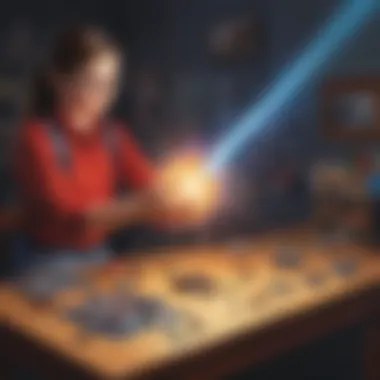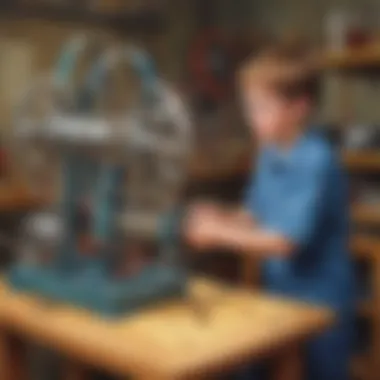Unleashing the Wonders of Physics: Engaging Projects for Young Minds


Science Fun Facts
Discover the Wonders of Science
Science Quiz Time
Science Experiment Showcase
Introduction
Physics education for elementary students serves as a foundational platform for cultivating young minds of tomorrow with a profound understanding of the physical world. By embracing the intricate concepts of physics at an early age, children can develop a robust framework of scientific knowledge that not only sharpens their analytical skills but also nurtures an innate curiosity towards the mysteries of the universe. This article elucidates the significance of introducing physics projects to young learners, emphasizing the immersive and experiential learning opportunities that can profoundly impact their educational journey.
Importance of Physics Education
Understanding basic principles
Untangling the webs of basic principles in physics lays the groundwork for a solid grasp of scientific phenomena. By unraveling concepts like motion, energy, and force in a simplified manner, children can seamlessly integrate these fundamental ideas into their cognitive repertoire. Encouraging hands-on exploration of basic principles nurtures a deeper understanding of the physical world, allowing young learners to connect theory with real-world applications effortlessly. Emphasizing the essence of these foundational principles primes students for advanced scientific explorations and fosters a strong scientific acumen from an early age.
Developing critical thinking skills
The realm of physics serves as an ideal landscape for honing critical thinking skills among young minds. By engaging in activities that prompt analytical reasoning, problem-solving, and logical deduction, students embark on a journey towards sharpening their cognitive aptitude. Developing critical thinking skills within the context of physics empowers children to approach challenges methodically, unravel intricacies, and formulate innovative solutions. This cognitive sharpening not only enhances their academic performance but also equips them with indispensable skills for navigating life's myriad complexities.
Fostering curiosity in science


Fueling a profound curiosity in the wonders of science is a pivotal objective in physics education. By instilling a sense of wonder and inquisitiveness towards scientific phenomena, educators can inspire a lifelong love for exploration and discovery. Fostering curiosity in science nurtures a spirit of inquiry, encouraging students to ask challenging questions, seek answers through experimentation, and unravel the mysteries of the natural world. This thirst for knowledge serves as a catalyst for continual learning, innovation, and a deep-rooted appreciation for the beauty of scientific inquiry.
Target Audience
Children aged 6-
Tailoring physics projects for children aged 6-12 opens a gateway to experiential learning and discovery. Recognizing the unique cognitive development phase of this age group, educational activities can be structured to align with their learning styles and cognitive capacities. Introducing young learners to hands-on experiments and interactive demonstrations not only fosters a keen interest in the subject but also cultivates essential skills like observation, prediction, and scientific inquiry. Physics projects curated for children aged 6-12 lay a robust foundation for a lifelong appreciation of science and technological advancements.
Parents seeking educational resources
For parents seeking enriching educational resources, delving into physics projects offers a unique avenue for collaborative learning experiences with their children. By participating in science-based activities together, parents can nurture a bond centered around exploration, experimentation, and shared discoveries. Encouraging parental involvement in their child's educational journey through physics projects not only enhances family dynamics but also fosters a positive attitude towards learning. Providing accessible resources for parents empowers them to actively engage in their child's academic development, reinforcing the importance of STEM education in a child's formative years.
Simple Physics Projects
Simple Physics Projects play a crucial role in this article by offering young learners hands-on experiences to grasp fundamental physics concepts. These projects serve as engaging tools that foster a deeper understanding of the physical world around us while nurturing a sense of inquiry and curiosity. By delving into experiments related to invisible forces, light and optics, mechanics, and heat, students can develop critical thinking skills and problem-solving abilities through interactive exploration.
Invisible Forces
Static electricity experiment
Introducing students to the Static electricity experiment opens up a world of discovery regarding the behavior of electric charges at rest. This experiment allows learners to witness firsthand phenomena such as the attraction and repulsion of objects without the need for complex equipment. By observing the effects of static electricity, students can enhance their comprehension of basic electrical principles and scientific inquiry. The unique feature of this experiment lies in its ability to captivate young minds with the simplicity of materials required, making it accessible and engaging for learners of all backgrounds.
Magnetism exploration
Exploring Magnetism provides students with a hands-on opportunity to investigate magnetic properties and the interactions between magnetic fields. Through Magnetism exploration, learners can experiment with the forces of attraction and repulsion displayed by magnets, gaining an understanding of magnetic poles and fields. This project's distinctive feature is its ability to stimulate curiosity about the invisible forces at play in our everyday lives, inspiring a sense of wonder and intrigue among young scientists.
Light and Optics
Building a simple periscope
The Building a simple periscope project introduces students to the principles of mirrors and reflection in a fun and interactive way. By constructing a periscope, learners can explore how light behaves when it strikes a reflective surface and changes direction. This project highlights the importance of optics in shaping our visual experiences and encourages creativity in designing novel optical devices. The advantageous aspect of this project lies in its hands-on nature, allowing students to witness firsthand the magic of reflection and refraction.


Spectrum creation with prisms
Engaging students in Spectrum creation with prisms offers a fascinating insight into the dispersion of light into its constituent colors. Through this project, learners can observe how white light separates into a spectrum of colors when passed through a prism, demonstrating the concept of refraction. The appeal of this experiment lies in its ability to unveil the colorful world of optics, inspiring a sense of wonder and experimentation with light. By exploring the unique properties of prisms, students can enhance their understanding of light behavior and the science of color.
Mechanics Made Fun
Balloon rocket experiment
The Balloon rocket experiment injects excitement into the study of mechanics by demonstrating Newton's third law of motion in a thrilling setup. By launching balloon-powered rockets, students can witness how action and reaction propel objects forward, showcasing the principles of thrust and propulsion. This project's key characteristic lies in its dynamic and kinetic nature, allowing students to engage actively in the exploration of forces and motion.
Simple machines investigation
Investigating Simple machines allows students to delve into the mechanical advantage and efficiency of basic tools like levers, pulleys, and inclined planes. By constructing and testing simple machines, learners can gain insight into how these devices can amplify force and facilitate work. The unique feature of this investigation lies in its hands-on approach, providing students with opportunities to experiment and problem-solve using practical tools.
Heat and Temperature
Solar oven construction
Constructing Solar ovens empowers students to harness solar energy and explore the principles of heat transfer and insulation. This project involves building a device that utilizes sunlight to generate heat for cooking or warming food, demonstrating the concepts of renewable energy and thermal conduction. The Solar oven's unique feature lies in its sustainability and environmental awareness, encouraging students to engage with eco-friendly technologies while learning about heat properties.
Thermal conductivity exploration
Exploring Thermal conductivity enables students to investigate how heat moves through different materials and substances. By conducting experiments to compare the conductivity of various materials, learners can understand the concept of heat transfer and insulation. This project's advantage lies in its practical relevance to daily life, as students learn about the importance of efficient insulation and energy conservation in heating and cooling processes.
Advanced Physics Projects
In delving into the realm of Advanced Physics Projects for elementary students, we encounter a gateway to a world of scientific exploration far beyond the confines of elementary knowledge. These projects serve as a stepping stone towards developing a deeper understanding of complex physical phenomena. By engaging with advanced projects, students not only enhance their knowledge but also cultivate essential skills such as problem-solving, analytical thinking, and experimental design. Advanced Physics Projects play a vital role in nurturing a passion for science and expanding the horizons of young minds.
Electricity and Circuits
Creating a simple circuit


Exploring the intricacies of Creating a simple circuit unveils the fundamental principles of electricity in a hands-on and accessible manner. This project allows students to grasp the concept of a closed loop system where electricity flows uninterrupted. The key characteristic of Creating a simple circuit lies in its simplicity yet effectiveness in demonstrating the flow of electric current. This project serves as a foundational building block in understanding more complex electrical systems. While its straightforward nature may seem basic, the significance of grasping circuitry basics cannot be overstated, making it an essential inclusion in this educational arsenal.
Series and parallel circuits experiment
Through the Series and parallel circuits experiment, students embark on a journey to comprehend the difference between series and parallel connections. This experiment showcases how components are arranged in a circuit and the impact on overall current flow. The key characteristic of this experiment is its ability to visually demonstrate the variance between series and parallel setups, making abstract electric theories tangible. By illustrating the behavior of circuits in varying configurations, students can grasp nuances that form the foundation of electrical engineering. Despite its slightly more advanced nature, this experiment serves as a crucial bridge to understanding circuit complexities in a practical manner.
Sound Science
Making a DIY musical instrument
Engaging in Making a DIY musical instrument introduces students to the relationship between sound waves and physical constructs. This project not only encourages creativity but also provides insight into how vibrations produce sound. The key characteristic of Making a DIY musical instrument lies in its interactive nature, allowing students to witness sound production firsthand through their creations. By intertwining art and science, this project offers a multidimensional learning experience that sparks curiosity and innovation. Despite potential challenges in fine-tuning instrument design, the benefits of hands-on sound exploration make this project a valuable addition to the educational repertoire.
Sound wave visualization
Delving into Sound wave visualization leads students to uncover the visual representation of sound propagation. This project elucidates the concept of sound waves through visually compelling means. The key characteristic of this visualization lies in its capacity to transform abstract sound waves into observable patterns, aiding in the comprehension of wave behaviors. By providing a tangible link between auditory perception and visual demonstration, this project enhances students' understanding of wave phenomena. Despite the need for precise equipment and calibration, the experiential nature of this project enriches the educational journey, making it a noteworthy inclusion in the exploration of sound science.
Astrophysics Adventures
Modeling the solar system
Embarking on Modeling the solar system immerses students in a hands-on depiction of celestial movements and planetary interrelations. This project allows students to construct a scaled-down version of our solar system, offering insights into planetary orbits and sizes. The key characteristic of Modeling the solar system lies in its capacity to contextualize complex astronomical concepts in a tangible format. By visually representing the relative positions of planets, students gain a holistic view of our cosmic neighborhood. Despite the meticulous details required for accurate modeling, the profound educational benefits make this project an invaluable tool for astronomical comprehension.
Studying lunar phases
Engaging in Studying lunar phases equips students with the tools to observe and comprehend the lunar cycle. This project enables students to explore the varying appearances of the moon throughout its monthly orbit. The key characteristic of Studying lunar phases lies in its ability to demonstrate the relationship between the Earth, Sun, and Moon, leading to the observed lunar changes. By actively tracking and recording lunar phases, students deepen their understanding of celestial mechanics. Despite the necessity for consistent observation and documentation, the hands-on nature of this project enhances students' astronomical knowledge, making it a meaningful venture into astrophysics.
Conclusion
In the culmination of this intricate exploration into Physics Projects for Elementary Students, it becomes evident that fostering scientific curiosity at a young age is paramount in nurturing future innovators and critical thinkers. The essentiality of instilling a love for physics lies in its ability to transcend mere facts, delving into the realms of problem-solving, logical reasoning, and creativity. By immersing children in hands-on experiments and activities, this article endeavors to not only impart knowledge but also ignite a passion for the sciences that can potentially shape their academic and professional trajectories. Placing an emphasis on the practical applications of theoretical concepts, the adoption of these projects can enrich educational experiences and bolster a lifelong interest in the mysteries of the physical world.
Encouraging Scientific Curiosity
Inspiring a love for physics
At the core of inspiring a love for physics among young learners is the cultivation of inquisitiveness and an appreciation for the natural laws that govern our universe. By showcasing the wonders of physics through interactive experiments and thought-provoking activities, children are encouraged to question, explore, and theorize, fostering a mindset primed for scientific inquiry. The unique allure of this approach lies in its ability to transform complex ideas into tangible and engaging experiences, sparking a curiosity that transcends the classroom and permeates everyday life. By nurturing a fascination for the fundamental principles of physics, students are empowered to see the world through a lens of discovery and innovation.
Promoting STEM education
A cornerstone of modern education, promoting STEM (Science, Technology, Engineering, and Mathematics) initiatives serves as a catalyst for cultivating a generation of versatile thinkers and problem solvers. Within the context of physics projects for elementary students, the integration of STEM education amplifies the relevance and practicality of scientific principles, creating a bridge between theoretical knowledge and real-world applications. By emphasizing interdisciplinary connections and holistic learning experiences, STEM education not only equips students with technical skills but also nurtures attributes such as collaboration, adaptability, and critical analysis. Through the promotion of STEM education in the realm of physics projects, children are encouraged to explore the interconnectedness of various scientific disciplines, laying a robust foundation for future academic pursuits and career prospects.







